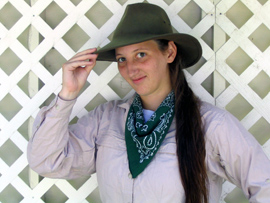|
Learning about the Medicine Wheels
Trying to unravel the mysteries of medicine wheels can seem like a daunting task.
Where does one begin? Do you try to figure out how old it is and then attempt to decipher its
purpose, or do you try to find a purpose to help figure out how old it is? Sometimes
it can seem like an endless circle. Exploring medicine wheels offers the exciting
prospect of integrating different fields of study together to assist in unraveling a
complex puzzle.
Archaeology
Archaeology is the study of the human past through materials that are left behind.
You can piece together the truth about a society through examination of
ancient structures, artifacts like pottery and tools, art pieces, and if it is available, oral tradition.
Because the builders of the Medicine Wheels are long gone, we have to use archaeology
to learn more about the ancient peoples of North America. To interpret their structures,
we need to have a better understanding of their culture, how they lived, and, to the
extent possible, what were their beliefs.
If you'd like to learn more about archaeology, check out:
Archaeology in South Dakota.

Archaeologist Rin Scherrer
Cultural Anthropology
Culture is a part of every human society. It can be defined as our way of life, our
morals, our social structure, our art, and our customs. It can be anything dealing
with the dynamic human experience. Cultural anthropology is the study of the broad
range of human culture, whether it be modern or ancient.
It is important to understand the culture of the Native American people before you
speculate about why they might build medicine wheels.
|
Carbon Dating
Carbon dating (radioactive dating) is one of the most effective ways we have of
discovering the age of organic material. Carbon 14 is an element present in all
organic matter. It is formed into carbon dioxide in the atmosphere and absorbed by
plants during photosynthesis. Carbon 14 has a half life of 5,700 years, which is the
time it takes for half of the carbon 14 in a sample to decay. We can use this half
life to date a piece of organic matter by comparing how much carbon 14 remains to how
much is found normally. See
How Carbon-14 Dating Works.
Rocks are not made or organic matter so cannot be dated. However, remains
of fire pits or scraps of wood used as central poles can help us determine
how old a medicine wheel site might be.
Astronomy
There is strong evidence that at least some medicine wheels
point to the Sun and some important stars.
The study of astronomy is necessary to understand where
objects are in the sky and how the passage of time affects their positions.
Being an astronomer helped Jack Eddy, discover the unique
aspects of the Bighorn Mountain medicine wheel.
|
Resources |
| Related Links:
|
Articles and Books:
- Eddy, John A; 1974 Astronomical Alignments of the Bighorn Medicine
Wheel. Science 184(4141):1035-1043.
- "Medicine Wheels and Plains Astronomy," in Native American
Astronomy," Anthony F. Aveni (Ed.), pp. 147-169. University of Texas
Press, Austin, 1979.
- Williamson, Ray A., Living the Sky: The Cosmos of the
American Indian. University of Oklahoma Press, 1987; ISBN
0-8061-2034-7.
- Kehoe, Alice B. and Thomas F.;
1979; "Solstice-Aligned Boulder Configurations in Saskatchewan."
Canadian Ethnology Service Paper No. 48. National Museum of Man,
Ottawa.
- Haack, Steven C.;
1987; "A Critical Evaluation of Medicine Wheel Astronomy." Plains
Anthropologist 32 (115): 77-82.
- Kehoe, Thomas F and Alice B.;
1987; Reply to Haack. Plains Anthropologist 32 (117): 323.
- Haack, Steven C.;
1987; Haack Responds. Plains Anthropologist 32 (117): 324.
- Brumley, John H.;
1988; "Medicine Wheels on the Northern Plains: A Summary and
Appraisal." Archaeological Survey of Alberta Manuscript Series No. 12, Edmonton.
|
| Activities:
|
Imagery:
- Sunrises
- Heliacal risings:
- Aldebaran rising 2 days before the Summer Solstice
- Rigel rising 28 days after the Summer Solstice
- Sirius rising 28 days after Rigel's dawn rising
and signifying the end of summer and time to leave the mountain
|
Return to Ancient Observatories -- Timeless Knowledge
|

